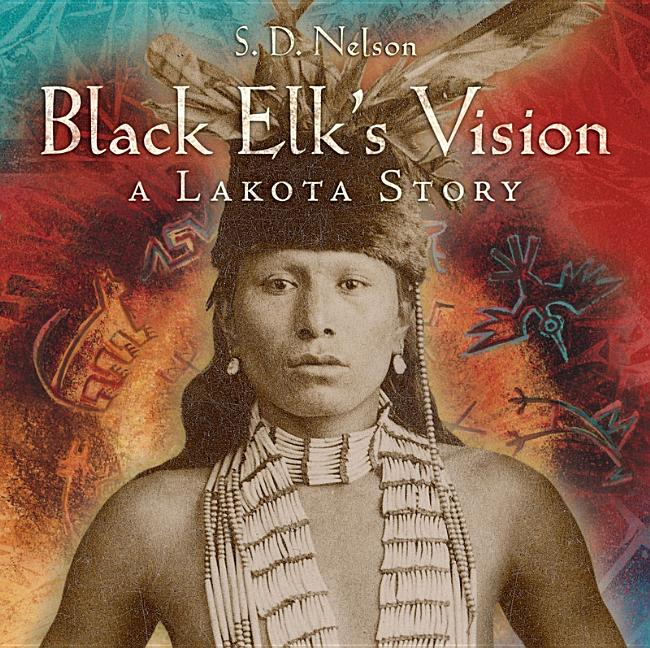Book Descriptions
for Black Elk's Vision by S.D. Nelson
From Cooperative Children's Book Center (CCBC)
An account of the life of Black Elk, the Lakota-Oglala medicine man, is based largely (but not wholly) on Black Elk Speaks and strikingly illustrated by artist S. D. Nelson. Born in 1863, Black Elk’s Great Vision came to him when he was nine years old. As he grew into adulthood he became known in his community as someone who could heal others through his connection to the Spirit World. Black Elk fought in the Battle of Little Big Horn, saw the slaughter of the buffalo that were so important to Lakota survival, and witnessed the Wounded Knee massacre. He worked in Buffalo Bill’s Wild West show, a stereotypical production in which Indians pretended to die at the hands of cowboys, in part to try to learn about the Wha-shi-choo (“Wasichu” in Lakota, meaning white man). Throughout his life, he held fast to his vision, which affirmed the circle of life, of support and respect. S. D. Nelson’s stunning artwork offers an expressive, cohesive visual accompaniment to the narrative, which is also enhanced by archival black-and-white photographs. A timeline, source notes, and other material round out the volume. (Ages 9–13)
CCBC Choices 2011. © Cooperative Children's Book Center, Univ. of Wisconsin - Madison, 2011. Used with permission.
From the Publisher
Black Elk’s Vision is a stunning picture book biography of the celebrated Lakota-Oglala medicine man from award-winning author and illustrator S. D. Nelson.
Black Elk (1863–1950) was a Lakota-Oglala medicine man and a cousin of Crazy Horse. This biographical account follows him from childhood through adulthood, recounting the visions he had as a young boy and describing his involvement in the battles of Little Big Horn and Wounded Knee, as well as his journeys to New York City and Europe with Buffalo Bill’s Wild West Show.
Award-winning author and member of the Standing Rock Sioux tribe S. D. Nelson tells the story of Black Elk through the voice of the medicine man, bringing to life what it was like to be Native American from the mid-19th century to the early 20th century. The Native people found their land overrun by the wasichus (White Man), the buffalo slaughtered for sport, and their people gathered onto reservations.
Interspersing archival images with his own artwork, inspired by the ledger-art drawings of the 19th-century Lakota, Nelson conveys how Black Elk clung to his childhood vision, which planted the seeds to help his people—and all people—understand their place in the Circle of Life. Backmatter includes a Lakota description of the Circle of Life, a brief history of the Lakota and a timeline.
Black Elk (1863–1950) was a Lakota-Oglala medicine man and a cousin of Crazy Horse. This biographical account follows him from childhood through adulthood, recounting the visions he had as a young boy and describing his involvement in the battles of Little Big Horn and Wounded Knee, as well as his journeys to New York City and Europe with Buffalo Bill’s Wild West Show.
Award-winning author and member of the Standing Rock Sioux tribe S. D. Nelson tells the story of Black Elk through the voice of the medicine man, bringing to life what it was like to be Native American from the mid-19th century to the early 20th century. The Native people found their land overrun by the wasichus (White Man), the buffalo slaughtered for sport, and their people gathered onto reservations.
Interspersing archival images with his own artwork, inspired by the ledger-art drawings of the 19th-century Lakota, Nelson conveys how Black Elk clung to his childhood vision, which planted the seeds to help his people—and all people—understand their place in the Circle of Life. Backmatter includes a Lakota description of the Circle of Life, a brief history of the Lakota and a timeline.
Publisher description retrieved from Google Books.


